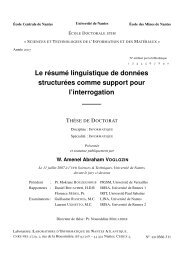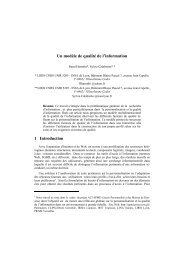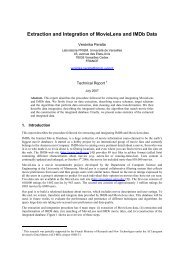Create successful ePaper yourself
Turn your PDF publications into a flip-book with our unique Google optimized e-Paper software.
72 J Intell Inf Syst (2006) 26: 59–73information in a response, for instance the response in example 4 might be “medium-thicknessmoderated-temperature materials are either s<strong>of</strong>t or hard but only a small part <strong>of</strong> them is hard”.Thus, taking advantage <strong>of</strong> the SAINTETIQ summarization process, our tool can performflexible querying not by applying fuzzy operators on classical data, but by applying booleaninclusion operators on the summaries, i.e., on fuzzy data. This is the main distinctivefeatures <strong>of</strong> our querying tool, with respect to other flexible querying mechanisms presentedin Section 2.5. Conclusion and future researchIn this paper, a querying tool for the summarization model SAINTETIQ has been proposed. Itallows end-users to efficiently retrieve summaries, and exploits the hierarchical structure <strong>of</strong>the summaries produced by SAINTETIQ.From a technical point <strong>of</strong> view, it performs a boolean matching between the summariesand the query on the basis <strong>of</strong> linguistic labels from a user-defined vocabulary. It is therefore aclassical boolean querying tool whose novelty lies in the use <strong>of</strong> summaries and in the efficientuse <strong>of</strong> a hierarchy. The querying machinery, as well as a user-friendly interface have beendeveloped and tested on toy examples in order to validate the method.Then, as it is easy to obtain tuples from summaries, and to rank the tuples according totheir membership degree to the summaries, it has been shown that the method can also beconsidered as a flexible querying tool on a relational <strong>database</strong>. The flexibility fully relies inthe summarization process, and this is one <strong>of</strong> the reasons why the process is efficient.Besides, this work is a first attempt at querying the summaries, and the richness <strong>of</strong> theframework is far from being entirely exploited. Several future developments are under consideration.Among them, the extension <strong>of</strong> the querying language, adding SQL-like functionsas count(), the possibility to use a wider vocabulary than the one used in the summarizationprocess, etc.Above all, expressiveness is the main point future work will focus on as it will eventuallyallow imprecision in not just the representation <strong>of</strong> information but also in user queries. It mightalso cover preferences or priorities in queries as mentioned by Rocacher in Rocacher (2003).An answer from the querying process, for example “thin materials have a s<strong>of</strong>t hardness anda normal temperature”, is a description <strong>of</strong> data. The embedding <strong>of</strong> the description operation(and others from <strong>summary</strong>-based querying) as an extension <strong>of</strong> SQL is a long-term futureproject.From the conjunctive normal form expression <strong>of</strong> queries, determining the reasons <strong>of</strong> asearch failure is simple (see 4.2). From then, an interaction with the user will permit us toimplement one <strong>of</strong> the cooperative behaviors (corrective answers) surveyed by Gaasterlandin Gaasterland et al. (1992). The reasons <strong>of</strong> a failure, that is the fuzzy labels in the querythat cause the failure, may be displayed so that the user could ask a new query based on theprevious one.ReferencesBosc, Patrick, & Pivert, Olivier (1994). Fuzzy queries and relational <strong>database</strong>s. In Proceedings <strong>of</strong> the ACMSymposium on Applied Computing, (pp. 170–174). Phoenix, AZ, USA.Cubero, Juan C., Medina, Juan M., Pons, Olga, & Amparo Vila, Miranda, María (1999). Data summarizationin relational <strong>database</strong>s through fuzzy dependencies. Information Sciences, 121(3/4), 233–270.Dubois, Didier, & Prade, Henri (1997). Using fuzzy sets in <strong>database</strong> systems: why and how? In Flexible QueryAnswering Systems (pp. 45–59). Kluwer Academic Publishers, Boston.Springer







